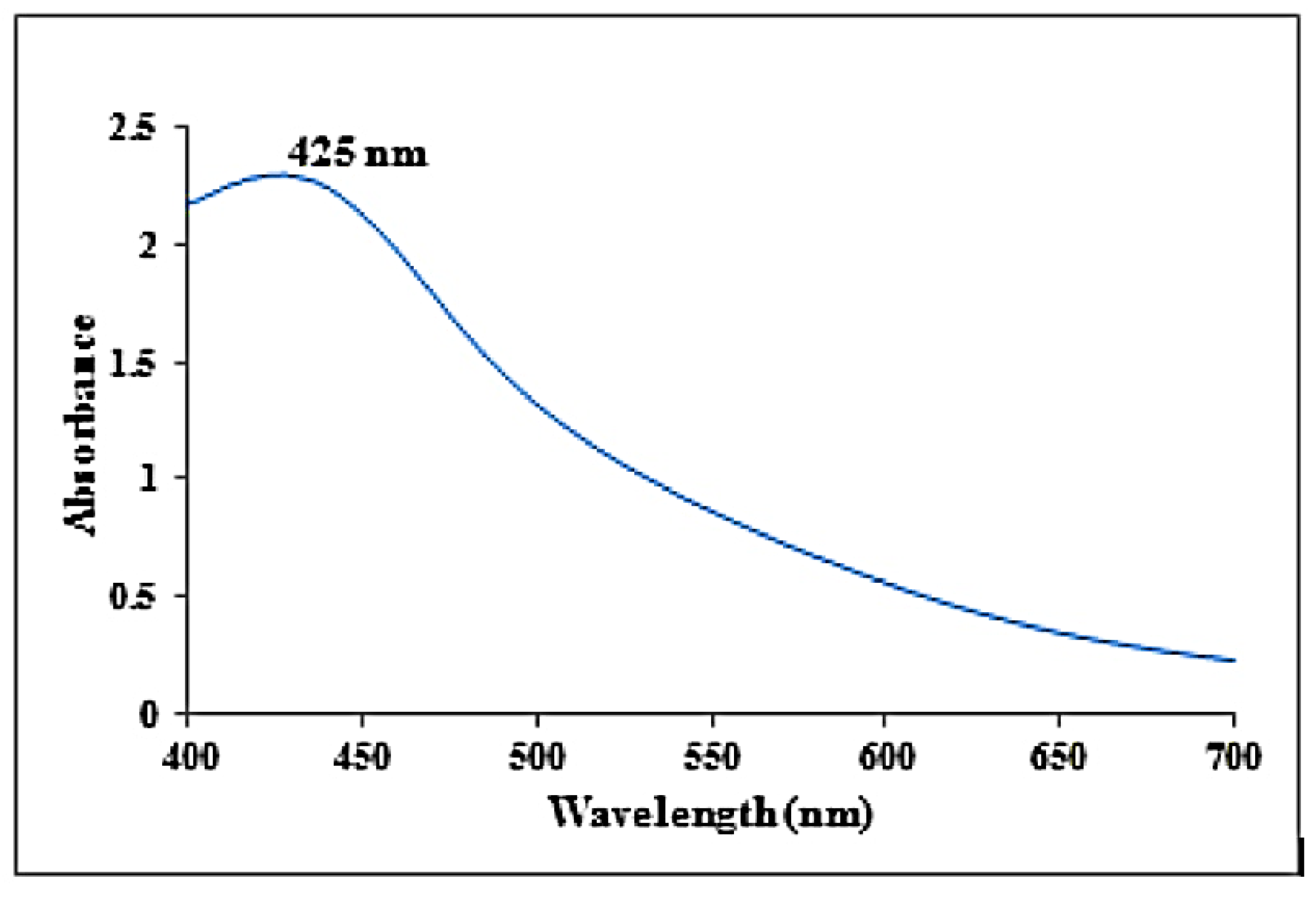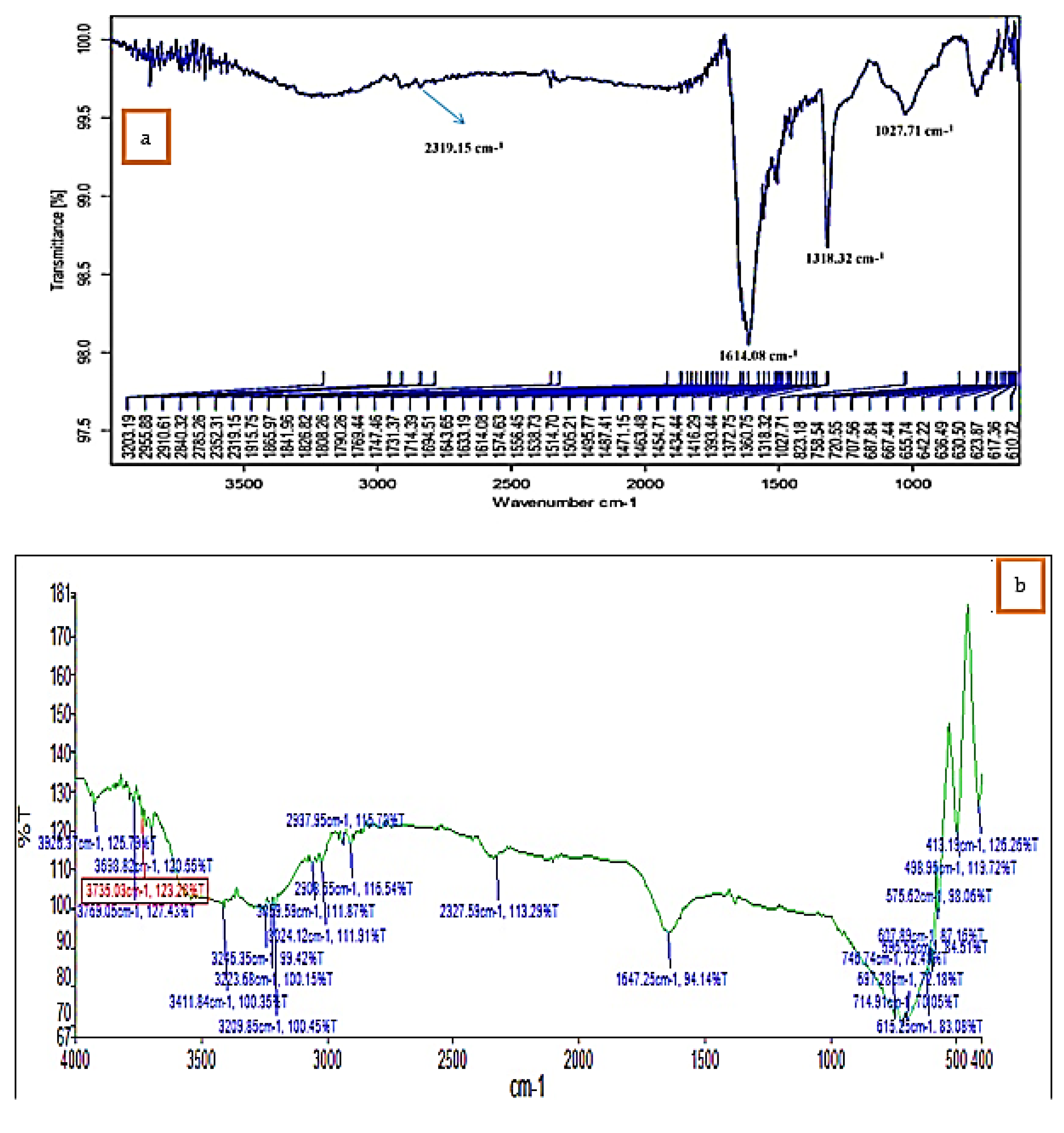Phytosynthesis of Silver Nanoparticle (AgNPs) Using Aqueous Leaf Extract of Knoxia sumatrensis (Retz.) DC. and Their Multi-Potent Biological Activity: An Eco-Friendly Approach
Abstract
1. Introduction
2. Materials and Methods
2.1. Plant Collection and Extraction
2.2. Synthesis
2.3. Characterization
2.4. Antioxidant
2.5. Anti-Proliferative Activity
2.5.1. Culture
2.5.2. MTT Assay
2.6. Larivicidal Activity
2.6.1. Larval Culture
2.6.2. Bioassay
2.7. Statistical Analysis
3. Results and Discussion
3.1. UV-Vis Spectral Analysis
3.2. X-ray Diffraction Studies
3.3. FT-IR Study
3.4. SEM and EDAX Analysis
3.5. Antioxidant Activity
3.6. Anti-Proliferative Activity
3.7. Larvicidal Activity
4. Conclusions
Supplementary Materials
Author Contributions
Funding
Institutional Review Board Statement
Informed Consent Statement
Data Availability Statement
Acknowledgments
Conflicts of Interest
Sample Availability
References
- Csakvari, A.C.; Moisa, C.; Radu, D.G.; Olariu, L.M.; Lupitu, A.I.; Panda, A.O.; Copolovici, D.M. Green synthesis, characterization, and antibacterial properties of silver nanoparticles obtained by using diverse varieties of Cannabis sativa leaf extracts. Molecules 2021, 26, 4041. [Google Scholar] [CrossRef] [PubMed]
- Nasrollahzadeh, M.; Sajjadi, M.; Dadashi, J.; Ghafuri, H. Pd-based nanoparticles: Plant-assisted biosynthesis, characterization, mechanism, stability, catalytic and antimicrobial activities. Adv. Colloid. Interface Sci. 2020, 276, 102103. [Google Scholar] [CrossRef]
- Taha, A.; Ben Aissa, M.; Da’na, E. Green synthesis of an activated carbon-supported Ag and ZnO nanocomposite for photocatalytic degradation and its antibacterial activities. Molecules 2020, 25, 1586. [Google Scholar] [CrossRef] [PubMed]
- Da’na, E.; Taha, A.; Afkar, E. Green synthesis of iron nanoparticles by Acacia nilotica pods extract and its catalytic, adsorption, and antibacterial activities. Appl. Sci. 2018, 8, 1922. [Google Scholar] [CrossRef]
- Lomelí-Rosales, D.A.; Zamudio-Ojeda, A.; Reyes-Maldonado, O.K.; López-Reyes, M.E.; Basulto-Padilla, G.C.; Lopez-Naranjo, E.J.; Velázquez-Juárez, G. Green synthesis of gold and silver nanoparticles using leaf extract of Capsicum chinense plant. Molecules 2022, 27, 1692. [Google Scholar] [CrossRef] [PubMed]
- Alahmad, A.; Feldhoff, A.; Bigall, N.C.; Rusch, P.; Scheper, T.; Walter, J.G. Hypericum perforatum L. -mediated green synthesis of silver nanoparticles exhibiting antioxidant and anticancer activities. Nanomaterials 2021, 11, 487. [Google Scholar] [CrossRef] [PubMed]
- Vivek, K.; Rao, R. Some interesting indigenous beverages among the tribals of Central India. Ind. J. Trad. Knowl. 2007, 6, 141–143. [Google Scholar]
- Ayyanar, M.; Ignacimuthu, S. Herbal medicines for wound healing among tribal people in Southern India: Ethnobotanical and Scientific evidences. Int. J. Appl. Res. Nat. Prod. 2009, 2, 29–42. [Google Scholar]
- Loganathan, S.; Shivakumar, M.S.; Karthi, S.; Senthil-Nathan, S.; Selvam, K. Metal oxide nanoparticle synthesis (ZnO-NPs) of Knoxia sumatrensis (Retz.) DC. Aqueous leaf extract and It’s evaluation of their antioxidant, anti-proliferative and larvicidal activities. Toxicol. Repor. 2021, 8, 64–72. [Google Scholar] [CrossRef]
- World Health Organization (WHO). Dengue and Severe Dengue. 2009. Available online: https://apps.who.int/mediacentre/factsheets/fs117/en/index.html (accessed on 14 April 2021).
- World Health Organization (WHO). Promoting Dengue Vector Surveillance and Control. 2018. Available online: https://www.who.int/denguecontrol/disease/en/ (accessed on 23 April 2021).
- World Health Organization (WHO). World Malaria Report 2018. Available online: https://www.who.int/publications/i/item/9789241565653 (accessed on 23 April 2021).
- World Health Organization (WHO). Lymphatic filariasis: Managing morbidity and preventing disability: An aide-mémoire for national programme managers, 2nd ed. 2018. Available online: https://www.who.int/publications/i/item/lymphatic-filariasis-managing-morbidity-and-preventing-disability-an-aide-m%C3%A9moire-for-national-programme-managers-2nd-ed (accessed on 23 April 2021).
- Senthil-Nathan, S. A review of resistance mechanisms of synthetic insecticides and botanicals, phytochemicals, and essential oils as alternative larvicidal agents against mosquitoes. Front. Physiol. 2019, 10, 1591. [Google Scholar] [CrossRef]
- Vijayakumar, S.; Vaseeharan, B.; Sudhakaran, R.; Jeyakandan, J.; Ramasamy, P.; Sonawane, A.; Faggio, C. Bioinspired zinc oxide nanoparticles using Lycopersicon esculentum for antimicrobial and anticancer applications. J. Clust. Sci. 2019, 30, 1465–1479. [Google Scholar] [CrossRef]
- Loganathan, S.; Selvam, K.; Padmavathi, G.; Shivakumar, M.S.; Senthil-Nathan, S.; Gounder, S.A.; Ali, M.A.; Almutairi, S.M. Biological synthesis and characterization of Passiflora subpeltata ortega aqueous leaf extract in silver nanoparticles and their evaluation of antibacterial, antioxidant, anti-cancer and larvicidal activities. J. King Saud Univ. Sci. 2022, 22, 101846. [Google Scholar] [CrossRef]
- Shimada, K.; Fujikawa, K.; Yahara, K.; Nakamura, T. Antioxidative properties of xanthan on the autoxidation of soybean oil in cyclodextrin emulsion. J. Agric. Food. Chem. 1992, 40, 945–948. [Google Scholar] [CrossRef]
- Rajeshwar, Y.; Senthilkumar, G.P.; Malay, A.G.; Mazumder, U.K. Studies on in vitro antioxidant activities of methanol extract of Mucuma pruriens (Fabaceae) seeds. Europ. Bull. Drug. Res. 2005, 13, 131–138. [Google Scholar]
- Senthil-Nathan, S. Physiological and biochemical effect of neem and other Meliaceae plants secondary metabolites against Lepidopteran insects. Front. Physiol. 2013, 4, 359. [Google Scholar] [CrossRef]
- Mosmann, T. Rapid colorimetric assay for cellular growth and survival: Application to proliferation and cytotoxicity assays. J. Immunol. Methods. 1983, 65, 55–63. [Google Scholar] [CrossRef]
- World Health Organization (WHO). Communicable Disease Tool Kit, Sudan; WHO/CDS/2005; World Health Organization: Geneva, Switzerland, 2005; p. 26. [Google Scholar]
- Senthil-Nathan, S. A review of biopesticides and their mode of action against insect pest’s. In Environmental Sustainability—Role of Green Technologies; Springer: Berlin/Heidelberg, Germany, 2015; pp. 49–63. [Google Scholar]
- Abbott, W.S. A method of computing the effectiveness of an insecticide. J. Econ. Entomol. 1925, 18, 265–267. [Google Scholar] [CrossRef]
- Ssekatawa, K.; Byarugaba, D.K.; Kato, C.D.; Wampande, E.M.; Ejobi, F.; Nakavuma, J.L.; Kirabira, J.B. Green strategy–based synthesis of silver nanoparticles for antibacterial applications. Front. Nanotechnol. 2021, 3, 697303. [Google Scholar] [CrossRef]
- Shaikh, I.A.; Muddapur, U.M.; Bagewadi, Z.K.; Chiniwal, S.; Ghoneim, M.M.; Mahnashi, M.H.; Iqubal, S.M. Characterization of bioactive compounds from Acacia concinna and Citrus limon, silver nanoparticles’ production by A. concinna extract, and their biological properties. Molecules 2022, 27, 2715. [Google Scholar] [CrossRef]
- Balaraman, P.; Balasubramanian, D.; Kaliannan, D.; Durai, M.; Kamyab, H.; Park, S.; Maruthupandian, A. Phyco-synthesis of silver nanoparticles mediated from marine algae Sargassum myriocystum and its potential biological and environmental applications. Waste. Biomass. Valori. 2020, 11, 5255–5271. [Google Scholar] [CrossRef]
- Daphedar, A.; Taranath, T.C. Characterization and cytotoxic effect of biogenic silver nanoparticles on mitotic chromosomes of Drimia polyantha (Blatt. & McCann) Stearn. Toxicol. Repor. 2018, 5, 910–918. [Google Scholar]
- Kumar, S.P.; Darshit, P.; Ankita, P.; Palak, D.; Ram, P.; Pradip, P.; Kaliaperumal, S. Biogenic synthesis of silver nanoparticles using Nicotiana tobaccum leaf extract and study of their antibacterial effect. Afr. J. Biotechnol. 2011, 10, 8122–8130. [Google Scholar] [CrossRef]
- Morales-Lozoya, V.; Espinoza-Gómez, H.; Flores-López, L.Z.; Sotelo-Barrera, E.L.; Núñez-Rivera, A.; Cadena-Nava, R.D.; Rivero, I.A. Study of the effect of the different parts of Morinda citrifolia L. (noni) on the green synthesis of silver nanoparticles and their antibacterial activity. Appl. Surf. 2021, 537, 147855. [Google Scholar] [CrossRef]
- Hemlata, P.; Meena, R.; Singh, A.P.; Tejavath, K.K. Biosynthesis of silver nanoparticles using Cucumis prophetarum aqueous leaf extract and their antibacterial and antiproliferative activity against cancer cell lines. ACS Omega 2020, 5, 5520–5528. [Google Scholar] [CrossRef] [PubMed]
- Vijayaraghavan, K.; Nalini, S.K.; Prakash, N.U.; Madhankumar, D. Biomimetic synthesis of silver nanoparticles by aqueous extract of Syzygium aromaticum. Mater. Lett. 2012, 75, 33–35. [Google Scholar] [CrossRef]
- Kumar, C.R.; Betageri, V.S.; Nagaraju, G.; Pujar, G.H.; Onkarappa, O.H.; Latha, M.S. Synthesis of core/shell (zno/ag) nanoparticles using Calotropis gigantea and their applications in photocatalytic and antibacterial studies. J. Inorg. Organomet. Polym. 2020, 30, 3410–3417. [Google Scholar] [CrossRef]
- Rudrappa, M.; Rudayni, H.A.; Assiri, R.A.; Bepari, A.; Basavarajappa, D.S.; Nagaraja, S.K.; Nayaka, S. Plumeria alba-mediated green synthesis of silver nanoparticles exhibits antimicrobial effect and anti-oncogenic activity against glioblastoma u118 mg cancer cell line. Nanomaterials 2022, 12, 493. [Google Scholar] [CrossRef]
- Kiran, M.S.; Betageri, V.S.; Kumar, C.R.; Vinay, S.P.; Latha, M.S. In-vitro antibacterial, antioxidant and cytotoxic potential of silver nanoparticles synthesized using novel Eucalyptus tereticornis leaves extract. J. Inorg. Organomet. Polym. 2020, 30, 2916–2925. [Google Scholar] [CrossRef]
- Dhayalan, M.; Denison, M.I.J.; Krishnan, K. In vitro antioxidant, antimicrobial, cytotoxic potential of gold and silver nanoparticles prepared using Embelia ribes. Nat. Prod. Res. 2017, 31, 465–468. [Google Scholar] [CrossRef]
- Singh, J.; Dhaliwal, A.S. Novel green synthesis and characterization of the antioxidant activity of silver nanoparticles prepared from Nepeta leucophylla root extract. Anal. Biochem. 2019, 52, 213–230. [Google Scholar] [CrossRef]
- Edwin, E.; Vasantha-Srinivasan, P.; Senthil-Nathan, S.; Thanigaivel, A.; Ponsankar, A.; Pradeepa, V.; Selin-Rani, S.; Kalaivani, K.; Hunter, W.B.; Abel-Megeed, A.; et al. Anti-dengue efficacy of bioactive andrographolide from Andrographis paniculata (Lamiales: Acanthaceae) against the primary dengue vector Aedes aegypti (diptera: Culicidae). Acta Trop. 2016, 163, 167–178. [Google Scholar] [CrossRef] [PubMed]
- Ajayi, E.; Afolayan, A. Green synthesis, characterization and biological activities of silver nanoparticles from alkalinized Cymbopogon citratus Stapf. Adv. Nat. Sci. Nanosci. Nanotechnol. 2017, 8, 015017. [Google Scholar] [CrossRef]
- Bharathi, D.; Bhuvaneshwari, V. Evaluation of the cytotoxic and antioxidant activity of phyto-synthesized silver nanoparticles using Cassia angustifolia flowers. Bionanoscience 2019, 9, 155–163. [Google Scholar] [CrossRef]
- Venugopal, K.; Rather, H.A.; Rajagopal, K.; Shanthi, M.P.; Sheriff, K.; Illiyas, M.; Maaza, M. Synthesis of silver nanoparticles (Ag NPs) for anticancer activities (MCF 7 breast and A549 lung cell lines) of the crude extract of Syzygium aromaticum. J. Photochem. Photobiol. B 2017, 167, 282–289. [Google Scholar] [CrossRef]
- Yadav, A.; Mendhulkar, V.D. Antiproliferative activity of Camellia sinensis mediated silver nanoparticles on three different human cancer cell lines. J. Cancer Res. Ther. 2018, 14, 1316–1324. [Google Scholar] [PubMed]
- Sivasakthi, V.; Selvam, K.; Prakash, P.; Shivakumar, M.S.; Senthil-Nathan, S. Characterization of silver nanoparticles using Ixora brachiate Roxb. and its biological application. Curr. Opin. Green. Sustain. Chem. 2022, 28, 100257. [Google Scholar] [CrossRef]
- Rajkumar, R.; Shivakumar, M.S.; Senthil-Nathan, S.; Selvam, K. Preparation and characterization of chitosan nanocomposites material using silver nanoparticle synthesized Carmona retusa (Vahl) Masam leaf extract for antioxidant, anti-cancerous and insecticidal application. J. Clust. Sci. 2019, 30, 1145–1155. [Google Scholar] [CrossRef]




| Wave Number (CM−1) | Intensity | Group Compound | Functional Group |
|---|---|---|---|
| 3411.84 | Medium | OH | Alcohols, Phenols |
| 3209.85 | Medium | OH | Carboxylic acids |
| 2908.55 | Strong | C-H | Alkanes |
| 2327.59 | Medium | P-H | Phosphines |
| 1647.25 | Medium-Strong | C=C | Alkene |
| Wave Number (CM−1) | Intensity | Group Compound | Functional Group |
|---|---|---|---|
| 2319.15 | Strong | CH | Methylene |
| 1614.08 | Medium | C=C | Alkenes |
| 1318.32 | Medium-Strong | C–N | Amines |
| 1027.71 | Strong | C–X | Fluoride |
Publisher’s Note: MDPI stays neutral with regard to jurisdictional claims in published maps and institutional affiliations. |
© 2022 by the authors. Licensee MDPI, Basel, Switzerland. This article is an open access article distributed under the terms and conditions of the Creative Commons Attribution (CC BY) license (https://creativecommons.org/licenses/by/4.0/).
Share and Cite
Loganathan, S.; Selvam, K.; Shivakumar, M.S.; Senthil-Nathan, S.; Vasantha-Srinivasan, P.; Gnana Prakash, D.; Karthi, S.; Al-Misned, F.; Mahboob, S.; Abdel-Megeed, A.; et al. Phytosynthesis of Silver Nanoparticle (AgNPs) Using Aqueous Leaf Extract of Knoxia sumatrensis (Retz.) DC. and Their Multi-Potent Biological Activity: An Eco-Friendly Approach. Molecules 2022, 27, 7854. https://doi.org/10.3390/molecules27227854
Loganathan S, Selvam K, Shivakumar MS, Senthil-Nathan S, Vasantha-Srinivasan P, Gnana Prakash D, Karthi S, Al-Misned F, Mahboob S, Abdel-Megeed A, et al. Phytosynthesis of Silver Nanoparticle (AgNPs) Using Aqueous Leaf Extract of Knoxia sumatrensis (Retz.) DC. and Their Multi-Potent Biological Activity: An Eco-Friendly Approach. Molecules. 2022; 27(22):7854. https://doi.org/10.3390/molecules27227854
Chicago/Turabian StyleLoganathan, Settu, Kuppusamy Selvam, Muthugounder Subaramanian Shivakumar, Sengottayan Senthil-Nathan, Prabhakaran Vasantha-Srinivasan, Dhakshinamoorthy Gnana Prakash, Sengodan Karthi, Fahad Al-Misned, Shahid Mahboob, Ahmed Abdel-Megeed, and et al. 2022. "Phytosynthesis of Silver Nanoparticle (AgNPs) Using Aqueous Leaf Extract of Knoxia sumatrensis (Retz.) DC. and Their Multi-Potent Biological Activity: An Eco-Friendly Approach" Molecules 27, no. 22: 7854. https://doi.org/10.3390/molecules27227854
APA StyleLoganathan, S., Selvam, K., Shivakumar, M. S., Senthil-Nathan, S., Vasantha-Srinivasan, P., Gnana Prakash, D., Karthi, S., Al-Misned, F., Mahboob, S., Abdel-Megeed, A., Ghaith, A., & Krutmuang, P. (2022). Phytosynthesis of Silver Nanoparticle (AgNPs) Using Aqueous Leaf Extract of Knoxia sumatrensis (Retz.) DC. and Their Multi-Potent Biological Activity: An Eco-Friendly Approach. Molecules, 27(22), 7854. https://doi.org/10.3390/molecules27227854










